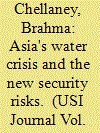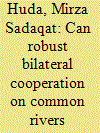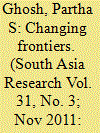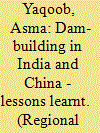|
|
|
Sort Order |
|
|
|
Items / Page
|
|
|
|
|
|
|
| Srl | Item |
| 1 |
ID:
115958


|
|
|
| 2 |
ID:
120414


|
|
|
|
|
| Publication |
2013.
|
| Summary/Abstract |
The Himalayan river system, which is made up of the Ganges, Brahmaputra and Meghna rivers, has a combined drainage area that covers the countries of China, India, Nepal, Bhutan and Bangladesh. The basin of the Indus river, which originates in the Tibetan plateau, is the lifeline of regions in China, Pakistan, India and Afghanistan. The perception of the subcontinent being an India-centric region does not arise solely from the disparities in resources and power, but also from the geographic reality of all countries in the region sharing a border with India, and some of the most significant rivers passing through its territory. India, thus, stands in a unique position to initiate vigorous multilateral cooperation on water issues in the region. Despite this, the low level of integration, perennial conflicts, mistrust and misinformation that have plagued relations between South Asian countries have hindered regional cooperation on water security.
|
|
|
|
|
|
|
|
|
|
|
|
|
|
|
|
| 3 |
ID:
107953


|
|
|
|
|
| Publication |
2011.
|
| Summary/Abstract |
This article focuses on patterns of the peopling of East Bengal from the seventeenth to the twentieth centuries and analyses the dynamics of this process in terms of the migrants' religious, social and political values. In this process, a number of boundaries were crossed, which South Asian Area Studies experts are still struggling to understand. Exploring this phenomenon of changing frontiers from a comparative historical perspective, the westward expansion of America during almost the same phase is analysed, showing similarities between the two phenomena, but also distinct dissimilarities. In Bengal, unlike America, there was no major violence involved and the migrations into Bengal were not at the cost of the native inhabitants, as largely happened in America. Arguing that, in grappling with the present Bangladesh-India relations, such historical knowledge is necessary, the article calls for greater interactions between intellectuals from both sides, which may be called Track III dialogue.
|
|
|
|
|
|
|
|
|
|
|
|
|
|
|
|
| 4 |
ID:
122427


|
|
|
| 5 |
ID:
165997


|
|
|
|
|
| Summary/Abstract |
This study examines the effect of energy resources on the chances for militarized conflict, water related conflict and cooperation events, and cooperative river treaties between pairs of states on shared international river basins. We examine trade-offs that riparian states can make between energy resources such as oil or natural gas and fresh water resources. Integrating upstream and downstream states’ geographical position in a river basin with energy resource information, we examine four related scenarios of states sharing rivers: (1) Joint energy where both upstream and downstream countries have energy resources, (2) Downstream energy where only the downstream state has energy resources, (3) Upstream energy where only an upstream country has energy resources, and (4) No energy. Theoretically, we argue that Downstream energy dyads are most likely to find cooperative solutions to conflicts over shared river resources because downstream states can offer oil and natural gas side payments to upstream states in exchange for greater water supplies. Empirical analyses of dyadic data in shared river basin dyads from 1945 to 2001 provide strong support for the theory. Riparian cooperation through river treaties and diplomacy is best achieved in Downstream energy dyads, where the downstream states have energy resources that can be traded for water resources with upstream states. Militarized conflict and water related conflict events are most likely in Joint energy dyads. Case illustrations from the Aral Sea and Ganges river basins are used to demonstrate the theoretical arguments.
|
|
|
|
|
|
|
|
|
|
|
|
|
|
|
|
|
|
|
|
|